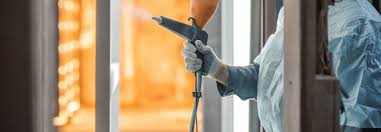The unique powder used in the process is a mixture of finely ground particles of pigment and resin, which is electrostatically sprayed onto the surface to be coated. This method has become increasingly popular over the last few decades due to its environmental advantages and the superior finish it provides.
Powder Coating Application Techniques
Let’s dive into the technical aspects. Powder coating application techniques vary, but the most common method is electrostatic spray deposition (ESD). This process involves charging powder particles as they pass through a spray gun and directing them toward the substrate. The grounded parts attract the charged particles, ensuring a uniform coat. Moreover, there’s also the fluidized bed application, mainly used for thicker coatings. Here, heated parts are dipped into a bed of aerated powder, causing the powder to melt and adhere to the surface. Each technique has its unique advantages, suited for different coating requirements.
Chemical and Physical Principles of Powder Coating
Understanding the science behind powder coating reveals why it’s such a durable and high-quality finish. At the microscopic level, the process involves the chemical bonding of polymer resins and pigments. When these powdered ingredients are heated in powder coating ovens, they undergo a transformation. The resin melts, encapsulating the pigment particles, and then chemically reacts to form long molecular chains, resulting in a high-density cross-linked coating. This chemical reaction, known as polymerization, gives powder-coated surfaces their impressive attributes like resistance to corrosion, impact, and UV radiation.
Role of Powder Coating Ovens in the Process
Powder coating ovens are pivotal to the curing process, transforming the sprayed-on powder into a seamless and durable finish. These industrial ovens are designed to provide uniform heat distribution, ensuring the powder melts and cures evenly across the entire surface. The temperature and time inside an oven are critical parameters that must be precisely controlled to achieve the desired coating properties. Too low a temperature or too short a curing time can result in a weak finish, while too high or too long can cause discoloration or other defects.
Industrial Applications and Advantages of Powder Coating
The versatility of powder coating is evident in its wide range of industrial applications. From automotive parts, such as wheels and bumpers, to everyday items like appliances and furniture, powder coating provides an attractive finish that is tough enough to withstand harsh environments. Its advantages over traditional liquid paint are numerous: it produces thicker coatings without running or sagging, emits negligible volatile organic compounds (VOCs), offers excellent color variety, and results in lower overall costs due to reduced waste and faster production cycles.
Environmental Considerations in Powder Coating Processes
Environmental stewardship is at the forefront of the powder coating industry. This process is inherently more environmentally friendly than traditional painting methods due to the absence of solvents, which means there are no harmful VOC emissions. Additionally, powder coating utilizes nearly 100% of the spray material, with overspray easily collected and reused, minimizing waste. These factors, combined with the long lifespan of powder-coated surfaces, contribute to reducing the environmental impact associated with coating and finishing processes.
In conclusion, the science behind powder coating is a fascinating blend of physics, chemistry, and engineering, culminating in a process that not only delivers superior aesthetic and functional qualities but also prioritizes environmental sustainability. As this technology continues to evolve, its application is set to expand, offering even greater benefits to industries and consumers alike.

